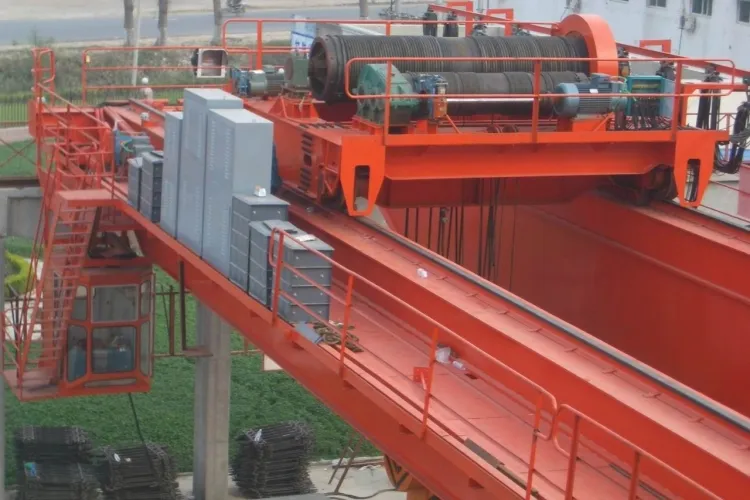- Mar 28, 2025
- News
Hot Metal Crane Requirements: Standards, Design Criteria
Explore the essential standards and design criteria for hot metal cranes. Ensure safety and efficiency in your operations by adhering to industry requirements.
Hot metal handling cranes, also known as hot metal ladle cranes, are essential equipment in steel mills and foundries. These cranes are designed to handle molten metal, which requires adherence to strict safety standards and performance requirements. This guide will delve into the hot metal crane requirements, focusing on key standards, safety features, braking systems, control systems, simulation testing, and compliance considerations.
Understanding Hot Metal Handling Cranes
Hot metal handling cranes are specialized cranes used to transport molten metal within steel mills or foundries. They play an important role in the safe and efficient operation of metal processing facilities. Their primary function is to lift and move ladles containing molten metal, ensuring that the transfer is carried out securely and efficiently.
Key Components of Hot Metal Cranes
- Hoist System: The hoist system is responsible for lifting and lowering the ladle. It must be robust and reliable to handle the weight and heat of the molten metal.
- Trolley and Bridge: The trolley moves along the bridge, which spans the area where the molten metal needs to be transported. The bridge and trolley must be sturdy and capable of withstanding high temperatures.
- Control System: The control system allows operators to manage the crane's movements precisely. It includes safety features to prevent accidents.
- Braking System: The braking system is crucial for stopping the crane safely, especially when handling heavy loads at high temperatures.
Design Considerations for Hot Metal Cranes
1. Material Selection and Structural Design
A primary factor in hot metal crane requirements is the selection of materials that can endure high temperatures without losing structural integrity. Cranes used in metallurgical applications are typically constructed from high-strength steel alloys and other materials that provide excellent heat resistance and durability. The design must consider the effects of thermal expansion and contraction, ensuring that all components, including beams, cables, and joints, maintain their strength and alignment under varying temperature conditions.
The structural design of hot metal handling cranes often incorporates reinforced elements to support heavy loads. This includes the use of double girder or even multi-girder configurations to distribute stresses more evenly. The design also takes into account deflection limits, ensuring that the crane's structure does not deform excessively under load. Industry guidelines generally specify a deflection limit of L/400 or similar ratios to guarantee safe operation.
2. Braking Requirements for Hot Metal Cranes
Due to the high temperatures and heavy loads involved, the braking requirements for hot metal cranes are very stringent. The braking system must be able to stop the crane quickly and safely. This requires cranes to have emergency stops, dynamic braking and mechanical brakes to ensure the braking performance of the equipment. Braking systems for hot metal treated cranes are much stricter than those for conventional cranes as the high temperature environment can be detrimental to the braking system. The electric hoist brake, for example, must be designed to function reliably even when the crane is exposed to heat radiated from molten metal. Regulations such as OSHA's 1910.179(f)(2)(vi) mandate that cranes handling hot metal and equipped with power control braking means have at least two holding brakes to enhance safety.
3. Power Supply and Control Systems
Hot metal cranes require robust power supply and control systems capable of operating in harsh environments. Many modern hot metal handling cranes incorporate variable frequency drives (VFDs) to regulate motor speed and improve energy efficiency. The use of VFDs allows for smooth acceleration and deceleration, reducing mechanical stress on the crane components and minimizing the risk of load swing.
Additionally, the control systems of these cranes must be designed to withstand the effects of high temperatures and potential electromagnetic interference. This is particularly important in environments where electrical components are exposed to heat and corrosive substances. Control panels and cab systems are often housed in insulated enclosures and are equipped with cooling systems to maintain optimal operating conditions.
Hot Metal Crane Standards and Regulations
Adherence to hot metal crane standards is essential for ensuring the safety and efficiency of these cranes. Several organizations and regulatory bodies have established guidelines and standards for hot metal cranes. Some of the key standards include:
- OSHA Regulations: The Occupational Safety and Health Administration (OSHA) provides guidelines for the safe operation of cranes, including hot metal handling cranes. These regulations cover aspects such as crane inspection, maintenance, and operator training.
- ANSI/ASME Standards: The American National Standards Institute (ANSI) and the American Society of Mechanical Engineers (ASME) have developed standards for crane design, operation, and maintenance. These standards ensure that hot metal cranes meet specific performance and safety criteria.
- ISO Standards: The International Organization for Standardization (ISO) provides global standards for crane safety and performance. These standards are particularly important for international operations.
Hot Metal Crane Safety Features
Safety is paramount when operating hot metal cranes. Key safety features include:
- Load Limiting Devices: These devices prevent the crane from lifting loads that exceed its capacity, ensuring safe operation.
- Overload Protection: Overload protection systems monitor the crane's load and stop it if the load exceeds safe limits.
- Emergency Stop Buttons: Emergency stop buttons should be easily accessible and clearly marked to allow operators to halt the crane instantly in case of an emergency.
Conclusion
Adherence to hot metal crane standards is essential for ensuring the safe and efficient operation of these cranes. By following the guidelines and requirements outlined in this guide, operators and maintenance personnel can minimize the risk of accidents and maximize productivity. For more detailed information, you can contact Yuantai Crane.





